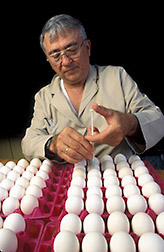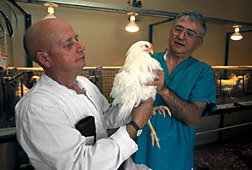Carrying New Vaccines to Newcastle
|
|
Foreign and domestic strains of Newcastle disease virus rank among the most dangerous economic threats to U.S. broiler and egg industries. But two kinds of experimental vaccines represent scientific firsts that offer new options to producers.
Henry D. Stone, an ARS veterinary medical officer, developed the vaccines over several years at the Southeast Poultry Disease Research Laboratory in Athens, Georgia. ARS is seeking patent protection. Further studies are under way in cooperative research and development agreements (CRADA's) with vaccine producers.
Newcastle virus was discovered in 1926 in Indonesia and near Newcastle-on-Tyne, England. Highly contagious, it can attack chickens, turkeys, parrots, partridges, cormorants, ostriches, and other wild and pet species. Typically, infected birds act fidgety, have trouble breathing, or have swelling around the eyes.
Deadly strains usually damage a bird's heart, liver, kidneys, brains, and intestines. But sometimes the only sign is depression, quickly followed by death.
USDA's Animal and Plant Health Inspection Service quarantines all legally imported birds that can carry the disease, until they're shown to be healthy. But smuggled birds and migrating waterfowl have introduced the deadly Newcastle strains known as velogenic viscerotropic or velogenic neurotropic. The former affects birds' inner organs, or viscera; the latter gravitates to the nervous system.
In 1971, pet birds from Latin America caused the only major U.S. outbreak. It infected broiler chicken and egg operations in California's San Bernardino Valley. Eradication took 2 years. To deprive the virus of hosts, 11 million poultry and other birds were destroyed within a quarantine zone covering 45,000 square miles.
While vaccination may keep a chicken free of symptoms, it won't prevent infection. And healthy-looking vaccinated chickens can still shed virus in their feces, sparking new outbreaks.
Newcastle vaccines use one of two kinds of antigen. The antigen triggers the bird's immune system to make antibodies to stop virus particles from latching onto cells. Newcastle antigen may be a live, weak virus strain—which sometimes causes disease—or an inactivated, "dead" virus.
Some producers prefer a dead-virus vaccine. They also prefer to vaccinate poultry early in life, to give the virus a smaller window of opportunity. The earliest vaccine is the in ovo, or "in egg" type. It is injected through the eggshell into the embryo. ARS scientists in East Lansing, Michigan, pioneered development of in-the-egg vaccines several years ago.
"When you inject a batch of grown chickens, a few usually squirm away and manage to avoid getting their shot, or a full dose," Stone says. "In ovo is much easier, and every bird gets vaccinated."
But today's in ovo vaccines use live-virus antigen. Stone's version would be the first to use inactivated virus. "Adapting a dead-virus Newcastle vaccine for commercial egg-injection machines would save much time and labor for producers who prefer not to use live-virus vaccines."
In a series of tests in a quarantine laboratory, Stone injected many groups of 18-day-old White Leghorn chicken embryos with varying doses of the experimental in ovo vaccine. Stone then exposed vaccinated and unvaccinated birds to a live, deadly strain of Newcastle virus 53 days after hatching.
All the unvaccinated birds died, but no disease symptoms appeared in any vaccinated birds. Stone found they also had no virus particles in the cloaca—the waste cavity. "This suggests they would shed less virus in their feces, an important route for spread of the disease," he says.
Stone's in ovo vaccine also produced Newcastle immunity in chickens when he combined it with in ovo vaccines for avian influenza and Salmonella. It is undergoing further tests through a CRADA between ARS and Maine Biological Laboratories, Inc., in Waterville.
When producers consider Newcastle vaccines for already-hatched chickens, they have two basic choices. Stone says they can opt for a dead-virus vaccine formulated in an emulsion of petroleum-based mineral oil. Or, they can pick a live-virus vaccine suspended in water or other non-oil liquid. But poultry workers may administer hundreds of doses, and airborne particles of live vaccine can cause minor eye irritation.
Live or dead, any injected vaccine requires some kind of liquid carrier—a "sea" in which microdrops of antigen float like plankton. And today's dead-virus vaccines for Newcastle have two drawbacks stemming directly from the mineral oil carrier. It can produce side effects, including skin and muscle lesions that make poultry unfit for processing. It can also persist in the chicken for several months.
To protect consumers, mineral-oil vaccine cannot be given to poultry within 42 days of slaughter. That restricts injecting a dead-virus vaccine into hatched broiler chickens, since they go to slaughter at about age 42 to 52 days.
Stone's alternative sidesteps the 42-day oil embargo because it doesn't use mineral oil.
He began by screening 19 test vaccines made using plant and animal oils such as soybean, corn, jojoba, canola, fish, and chicken. All induced immunity to the disease. Most had minor or no side effects.
Nearly all, however, were much more viscous—that is, less fluid—than vaccine containing mineral oil. Stone needed low viscosity, so vaccine could flow easily through a hypodermic into the animal's body.
To achieve this, he tried mixing soybean oil—relatively viscous, but plentiful and cheap—with synthetic oils of very low viscosity. The synthetics have various cosmetic, food, or other uses. Stone found that mixes of some synthetic oils with about 60 percent soybean oil kept total viscosity less than, or about equal to, mineral oil.
But this didn't solve another requirement—finding the right surfactant to use in the vaccine formulation.
Surfactant molecules securely wrap around each watery particle of antigen, somewhat as a wet suit protects a diver. Stone found that various mixes of three nonpetroleum surfactants used in skin cosmetics worked well in his experimental vaccine formulations.
One reason, he says, is that "the three surfactants have different chemistries. This keeps them from competing for the same positions on the surface of an aqueous antigen particle. Instead, they fit around it as if it were the center of a three-dimensional jigsaw puzzle."
More extensive tests of the vaccine and carrier are being run under a CRADA between ARS and Rhône Merieux, based in Lyon, France.
"Several of the experimental formulations," Stone says, "have high potency and meet shelf-life, stability, and most other criteria required by regulatory agencies."
He thinks the approach might work in developing dead-virus vaccines for other poultry diseases such as avian influenza or infectious bursal disease.
"Theoretically, it also has potential for vaccines for other livestock—and even humans," he says. — By Jim De Quattro, ARS.
Henry D. Stone is at the USDA-ARS Southeast Poultry Research Laboratory, 934 College Station Road, Athens, GA 30605; phone (706) 546-3434, fax (706) 546-3161.
"Carrying New Vaccines to Newcastle" was published in the November 1995 issue of Agricultural Research magazine.








